Egypt’s capital, Cairo is a city that mixes old and new in an exciting way. Cairo lies by the side of the Nile River and it is known for having some of the world’s most famous landmarks such as the Great Pyramids of Giza as well as the Sphinx. When visitors arrive here they have an opportunity to learn about different cultures at Egyptian Museum; they can go shopping at lively bazaars like Khan El Khalili or taste Egyptian dishes which are not found anywhere else.
It does not matter whether you are strolling around ancient quarters, sailing along the Nile river or enjoying night life in this city – there is always something interesting to do because Cairo offers variety activities for everyone. Because of these reasons Cairo remains one among many other fascinating places on earth which could attract any kind traveller.
Map
Pyramids of Giza
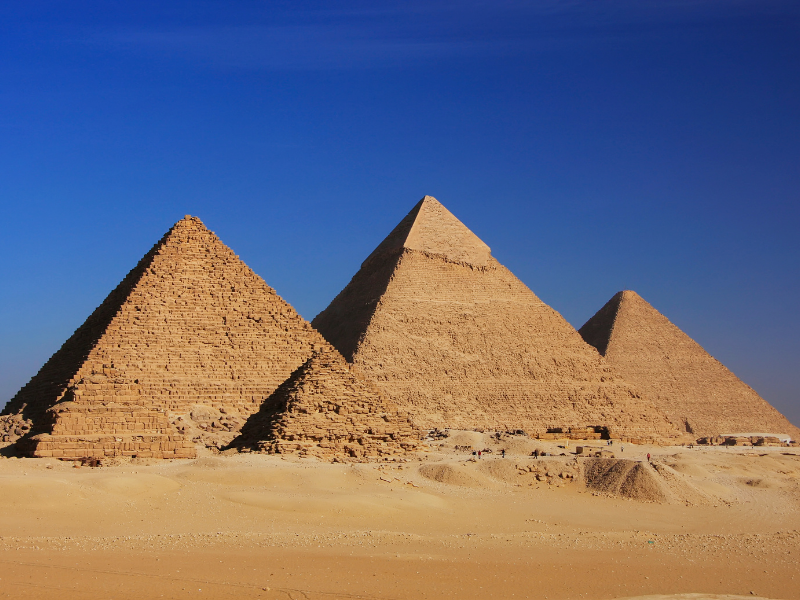
The Pyramids of Giza are located just outside Cairo, on the Giza Plateau. They are considered one of the most amazing architectural feats in history. This ancient complex was built over 4,500 years ago and includes the Great Pyramid of Khufu, the Pyramid of Khafre, and the Pyramid of Menkaure. There is also the Great Sphinx nearby. As they are the only surviving wonder from the ancient world, they continue to amaze people today with their size and mystery – providing a glimpse into Egypt’s long enigmatic past.
Historical Significance
Construction and Legacy: These pyramids were constructed as monumental tombs for pharaohs during Egypt’s Fourth Dynasty. The largest among them is called The Great Pyramid of Khufu which originally rose to a height of 146 meters making it the tallest structure built by humans for more than 3,800 years.
Engineering Marvel: The precision involved in building these structures still baffles historians and engineers alike because no one knows how such accuracy could have been achieved without modern technology or machinery. For example; they perfectly aligned themselves with certain celestial bodies while being made out compacted limestone blocks which demonstrates that Egyptians had advanced knowledge about astronomy as well physics.
Cultural and Ethical Considerations
Respect for Heritage: Visitors should not climb onto any part of this UNESCO World Heritage site nor should they ignore any local guidelines that may be in place to safeguard its conservation.
Souvenirs & Local Economy: It is advisable to bargain respectfully whenever dealing with vendors so as not only get genuine souvenirs but also enable them earn decent livelihoods through fair trade practices.
Nearby Attractions
- Great Sphinx: Enigmatic creature near pyramids – must see!
- Solar Boat Museum: Adjacent great pyramid; displays ancient cedar wood boat buried for afterlife transportation purposes .
- Cairo Museum: Located close to Giza; has wide range collection ancient Egyptian artifacts which can provide additional background information before or after visiting the pyramids.
The Sphinx

The Giza Plateau is home to the Great Sphinx of Giza, which is a famous statue made of limestone that has the body of a lion and the head of a pharaoh. Located near the Pyramids of Giza, this massive sculpture ranks among the oldest and largest monumental statues worldwide and has mesmerized scientists, historians, and tourists alike for many years. It is believed that this sphinx represents Pharaoh Khafre who constructed the second pyramid at Giza; thus enveloping it with an aura of enigma such as debates over its original function or when it was built.
Architectural And Historical Significance
Symbolism And Construction: The prevailing belief is that the Sphinx symbolizes strength and wisdom by protecting pharaonic tombs from desecration. Facing eastwards towards morning sun with a temple in front connects solar worship in ancient Egypt to this rock-carved monument.
Mysteries And Restoration: Throughout time natural decay coupled with human interference led to erosion on one hand while another saw several attempts being made at restoring different parts back into shape further obscuring proper understanding regarding what it originally looked like or how it worked.
Cultural And Ethical Considerations
Conservation Efforts: Conservation work may leave some areas around or even entire sections within the fenced off using scaffoldings whilst being repaired so as not damage any more parts than necessary. All visitors are therefore requested to honor these divisions by paying utmost respect for them since they help keep safe very old marvels from further deterioration.
Interaction With Locals: A lot of vendors and camel herders can be found near where tourists converge most especially around places such as these pyramids; although bargaining forms part-and-parcel local customs but if you don’t want things getting ugly later on make sure prices are agreed upon beforehand.
Nearby Attractions
- Pyramids Of Giza: This sphinx forms part larger complex housing other pyramids like those of Khufu known as Great Pyramid besides Khafre’s and Menkaure’s which are not too far away from each other hence can easily walk there within few minutes.
- Solar Boat Museum: Within the confines of this captivating museum lies a reconstructed funeral vessel belonging to Pharaoh Khufu that was discovered in one of his burial pits found at these pyramids complex area.
- Sound And Light Show At Giza: In case someone happens spend some evening hours around Giza district; then do not miss out on catching an enthralling storytelling session narrating events throughout Egypt’s history while illuminated against backdrop provided by both structures.
Egyptian Museum
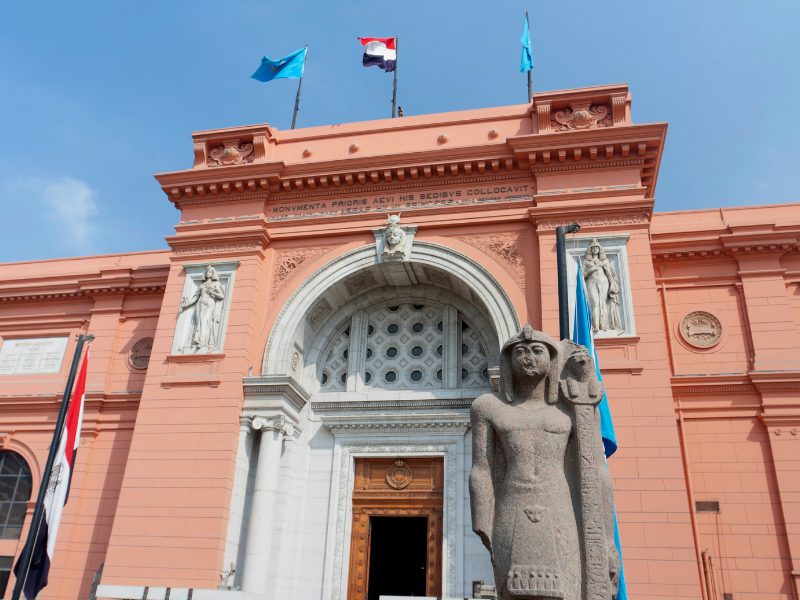
The Egyptian Museum is situated at the heart of Cairo, and acts as a door into history. There is no other place that holds as many artifacts from Egypt’s rich past. Over 120,000 items are kept in this museum. It showcases golden sarcophagi of royal mummies as well as daily life objects that give us an idea about what it was like to live in ancient times here on earth among gods and pharaohs.
The Museum of Egyptian Antiquities, also known by its official name the Egyptian Museum Cairo or simply “the egyptian museum” houses some unique collections which cannot be found anywhere else across the globe – all under one roof. You can find almost every important piece related with Ancient Egypt civilization like Tutankhamun’s burial mask; Pharaonic statues such as Ramses II; even famous Rosetta Stone itself displayed inside this iconic institution.
Architectural Significance
Historic Building: The red-colored neoclassical style building designed by French architect Marcel Dourgnon still stands today after being officially opened back in 1902 making it not only just another museum but rather an architectural wonder too where its large halls can take you through treasure hunting experience within their maze-like corridors which always keep changing just like those treasures hidden behind them waiting to be discovered by someone who knows what he/she is looking for!
Collection Highlights: With over 136 thousand pieces on display representing more than five millennia there are few places worldwide able boast such comprehensive collection covering virtually every aspect connected Pharonic culture including tomb goods belonging different periods ranging from prehistoric times up until Islamic period when country had already converted into Muslim nation thus leading among others things establishment new burial traditions throughout whole territory so if ever there was any doubt about depth breadth egyptian history then look no further because everything has been stored at once right here.
Artifacts and Exhibits
Treasures of King Tutankhamen: This is definitely one exhibit that you should not miss out on when visiting this museum. The artifacts displayed in this section alone are nothing short of breathtaking; including his gold mask and sarcophagus found at Valley of the Kings tomb along with many other valuable items which were buried alongside him like canopic jars used for storing Tutankhamen’s organs post mummification process among others.
Mummies of Pharaohs: For those who have always been interested in knowing what happened after death especially among ancient civilizations then they will find themselves drawn towards such places as Egyptian Museum Cairo where different types pharaonic burials can be seen first hand – from simple pits containing commoners’ bodies up until elaborate tombs hosting powerful rulers themselves complete their entire funerary equipment also known by name Ramses II Queen Hatshepsut just to mention few.
Nearby Attractions
- Tahrir Square: Tahrir square located outside the egyptian museum cairo is known as a place which had witnessed some significant events during recent history most notably 2011 egyptian revolution or arab spring if you may call it so. It has ever since become synonymous not only with political activism but also freedom struggle across whole middle east region thus making tahrir square very relevant even today as much was achieved there before anyone could imagine possible happening anywhere else anytime soon afterwards .
- Nile Corniche Walkway: Just within walking distance from our destination lies another great spot where visitors can enjoy panoramic views while taking stroll along nile river banks namely nile corniche walkway. This particular area offers perfect opportunity for people watching because there always seems to be something interesting going on around here whether its locals fishing off nearby bridge or tourists enjoying picnic lunch under shady trees while watching felucca boats sail past them lazily heading down stream towards open sea.
- Coptic Cairo District: In case you did not know already cairo being capital city means that it has something for everyone regardless of their religious affiliation hence places like coptic cairo district where one gets chance not only learn more about country’s rich christian heritage but also witness first hand how these beliefs have shaped egyptian society over centuries since arrival islam which brought with itself new set customs.
Khan El Khalili Bazaar
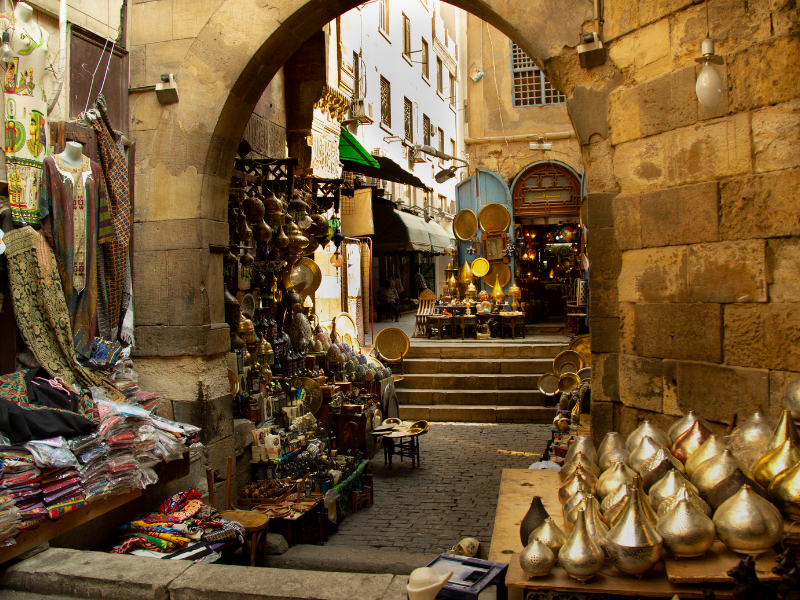
Located in the center of Islamic Cairo, the Khan El Khalili Bazaar is a lively labyrinth of history and culture. This market was established in the 14th century and has survived till today, adapting itself from being a commercial hub for traders to becoming a bustling district of business as well as tourism. The narrow streets and old buildings of this souk overwhelm one’s senses with various sights, sounds and smells. Khan El Khalili offers an endless choice when it comes to authentic Egyptian culture and craftsmanship – from finely decorated silverware through beautifully crafted carpets up to richly embroidered fabrics.
Social and Historical Relevance
Origins: Being built by Emir Djaharks el-Khalili as a caravanserai (a type of inn for merchants) in 1382 within Fatimid City which was located at the heart of medieval Cairo; it later became one among many worldwide famous open-air markets known today.
Architectural Beauty: Decorative latticework windows reflecting Islamic design; Arabic calligraphy adorning walls telling stories about past glories; gates dating back centuries showing different styles used during construction time are just few examples showcasing how much architectural charm there is around here representing Islam’s heights achieved architecturally speaking.
Crafts and Shopping
Different Products: Copper, gold, silver, leather goods ,perfumes ,ceramics antique stores lining the streets spice stalls selling all kinds of spices. These are some examples what can be found at khan el khalili where each item reflects years’ worths refining local skills.
Unique Keepsakes: There is no shortage when it comes to things that one could take home from Egypt either as gifts or mementos . For instance there are many shops which sell such items like traditional lamps made out glass or metalwork papyrus pictures depicting scenes ancient egyptian life even jewelries made out various materials including precious stones beads metals like copper bronze aluminum etcetera.
Nearby Attractions
- Al-Azhar Mosque: The mosque is not far away from the bazaar. It is one of the earliest Islamic buildings in Cairo and has been a university since the Fatimid dynasty.
- Islamic Cairo: Besides this, there are various other mosques scattered around here among them being those which have been turned into museums where people can learn more about egypt’s islamic heritage through artifacts like qurans written on palm leaves or prayer rugs dating back centuries etcetera.
- Museum of Islamic Art: A short drive from Khan El Khalili takes you to this museum that boasts some most exquisite examples representing different periods spanning across many countries throughout history because it houses one world richest collections.
Cairo Citadel
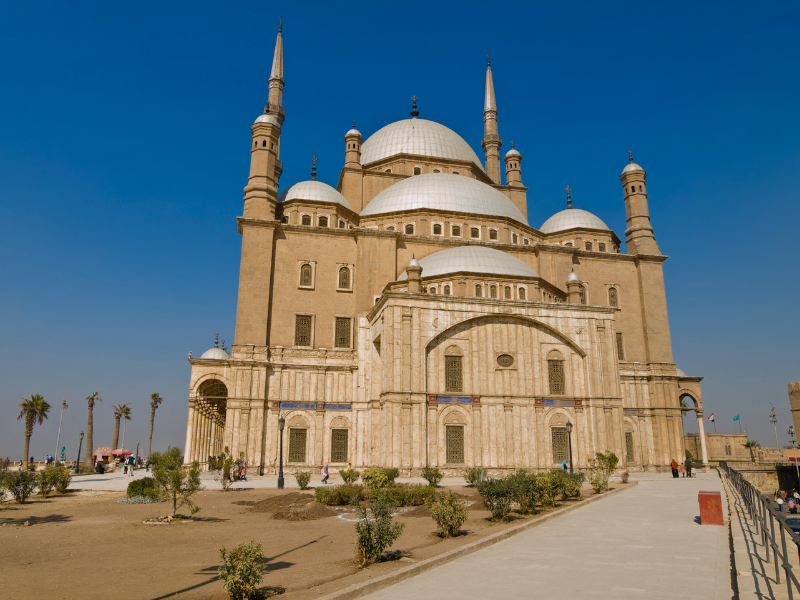
Standing on the Mokattam Hills in Cairo, the Saladin Citadel or Cairo Citadel is an immense fortress that has witnessed Egypt’s eventful history since its establishment by Salah al-Din in the late 12th century. Initially constructed as a defense against Crusader attacks, this citadel had many roles such as being a royal residence and military garrison but now serves as one of Cairo’s most popular tourist destinations. The walls are solidly built with an imposing appearance while its strategic position offers some of Cairo’s finest panoramic views not forgetting that it also provides visitors with an opportunity to study Islamic medieval military architecture closely.
Architectural and Historical Importance
Military Architecture: The battlements, towers and entrances of the citadel are excellent examples of mediaeval fortification design; located on top hills, this building dominated Cairo skyline acting as a major part for protection against foreign invasion.
Historical Change: Many rulers have made changes to this place over time including adding magnificent mosques and palaces which reflect different periods of Egyptian history under Mamluk, Ottoman and Ayyubid rule among others thus representing multi-layered nature typical of old cities like Cairo where each era leaves its own mark behind.
Cultural and Artistic Highlights
Mosque of Muhammad Ali: Commonly referred to as ‘Alabaster Mosque’, it is an ottoman style mosque situated at the highest point within Saladin castle grounds which makes it visible from any point in city hence attracting large numbers tourists annually who come see its massive dome topped minarets surrounded by luxurious décor consisting mostly alabaster stones both inside out thereby giving viewers much delight during their visit here lightened up more so when illuminated nightfall falls across all corners making sure no guest walks away without having been thrilled.
Museums & Exhibitions: There are several museums found here like Al-Gawhara Palace Museum showcasing artifacts from royal life; Military Museum containing weapons used during battles fought by Egyptians against foreign powers while Carriage Museum exhibits various types carriages used for transport purposes throughout different periods Egyptian history thus providing deeper understanding about aspects related with past events, social life style as well entertainment among others.
Nearby Attractions
- Khan El Khalili Bazaar: A vibrant market place just few steps away where visitors can buy souvenirs or simply enjoy window shopping while mingling with locals who trade various commodities here which creates vibrant atmosphere full colours sounds that are unique only found in such places like khan el khalili bazaar.
- Al-Azhar Park: This sprawling public park located nearby provides great escape after long day exploration characterized by lush green gardens offering stunning views back towards Saladin castle – Cairo citadel from elevated positions within its confines thereby giving people chance relax their minds bodies amidst natural beauty enhanced further when sun sets behind horizon casting golden glow over everything around including tall buildings closer proximity making look even more beautiful than they actually are during daytime hours spent walking through streets lined up shops cafes restaurants etc.
- Historic Cairo: There is no shortage historic sites around here; there many mosques scattered all over this part old city each having its own story tell; whether it be architectural design or historical events associated with them.
Mosque of Muhammad Ali
One among the most famous monuments of Cairo is the Mosque of Muhammad Ali, which sits on top of the Citadel. It was built from 1830 to 1848 and was ordered by Muhammad Ali Pasha, known as the father of modern Egypt. The reason for its nickname “Alabaster Mosque” lies in its shiny outside walls placed at an elevated position reflecting Egypt’s resurgence during the nineteenth century under his reign.
Architectural and Historical Significance
Design Inspiration: Being a Turkish-style architectural masterpiece in Cairo, this mosque draws heavily from Ottoman design especially Hagia Sophia found in Istanbul. This place has unique sparkle when morning breaks or evening falls because many parts are made up entirely out of alabaster.
Historical Role: Besides serving as a house for worship, it also acts as burial ground for Muhammad Ali Pasha whose body rests inside marble tomb within these walls.
Artistic and Cultural Highlights
Interior Splendor: When you walk into this mosque your breath will be taken away by its beauty – ceilings intricately designed with colored glass windows lining them; floors covered in ornate carpeting throughout; central dome painted gold on top with vibrant paintings below surrounded by four huge columns creating an even greater sense grandeur about such structure.
Panoramic Views: Sitting at eastern edge overlooking entire city below means that there are no better places than here if panoramic views over Cairo is what you want; hence popular choice for both photographers and tourists alike who flock daily just see breathtaking vista spread out before their eyes from atop hill whereon stands magnificent edifice called ‘mosque’.
Nearby Attractions
- Cairo Citadel Complex: There are several museums within close proximity which form part thereof hence making them worth visiting alongside other historical sites too numerous mention individually herein.
- National Military Museum situated in citadel area provides glimpse into Egypt’s military past covering various periods starting ancient times right upto present day conflicts while Al-Azhar Park located nearby offers largest green space within city limits complete with beautiful gardens as well additional panoramic outlooks over cairo.
Al-Azhar Mosque
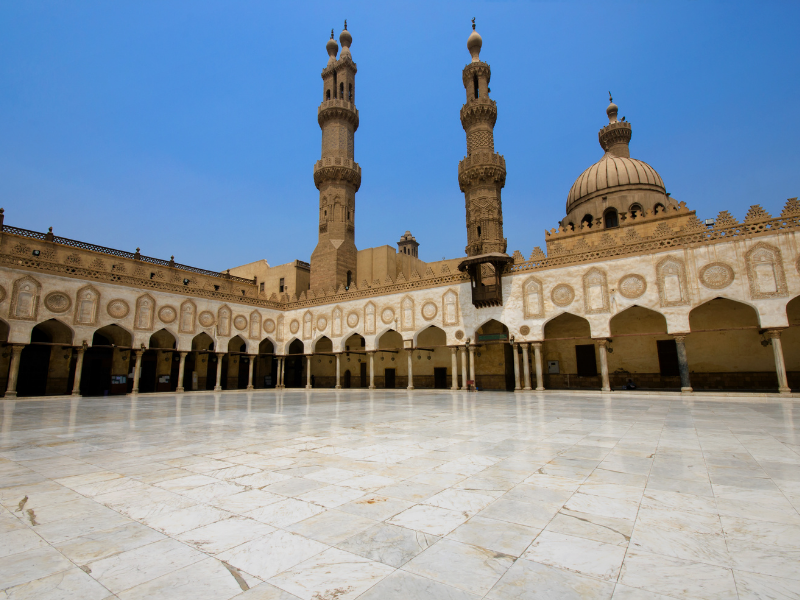
Positioned right in the middle of Islamic Cairo, Al-Azhar Mosque is one of the oldest and most prestigious mosques in the city. The mosque was established by the Fatimids in 970 AD as a congregational mosque and currently serves as the second oldest continuously operating university in the world; it has been a major center for Islamic theology and learning for over 1000 years.
Throughout history, Al-Azhar Mosque has played an important role not only as a religious institution but also as a place of academic pursuit. This makes it among the top visited sites within Egypt and other parts of the globe. Sprawling courtyards, prayer halls and minarets make up its design which reflects Egypts rich Islamic heritage alongside architectural splendor.
Architectural and Historical Significance
Foundation: First founded by Fatimid Caliphate rulers then later rebuilt or expanded upon to incorporate different style elements from various eras ranging between Ottoman times back through Mamluk days up until when it was initially created during early medieval period under fatimid reigns.
Unique Design: With five minarets having different styles, this mosque sits on an area where original designs used by Fatimids were mixed with those added during Mamluk rule then later on combined together with ottoman modifications thus showcasing how much Islamic architecture has evolved over time.
Cultural and Educational Role
Knowledge Hub: When talking about worldwide recognition none beats Al Azhar University which is associated with Al Azhar Mosque since both are among oldest universities globally known for their programs offering studies such as Sharia law, theology Islam Arabic literature etc., making them remain at forefront international institutions based around Sunni Islam teachings alone.
Nearby Attractions
- Khan El Khalili Bazaar: Located within walking distance from the mosque, this bustling market offers a wide range of shopping options ranging from traditional crafts to spices and jewelry.
- Hussein Mosque: Another major Islamic site in close proximity to Al-Azhar, housing oldest complete manuscript of Quran.
- Islamic Cairo District: Other historical mosques, madrasas and monuments can be found around Al-Azhar that provide insight into the medieval Islamic world.
Coptic Cairo
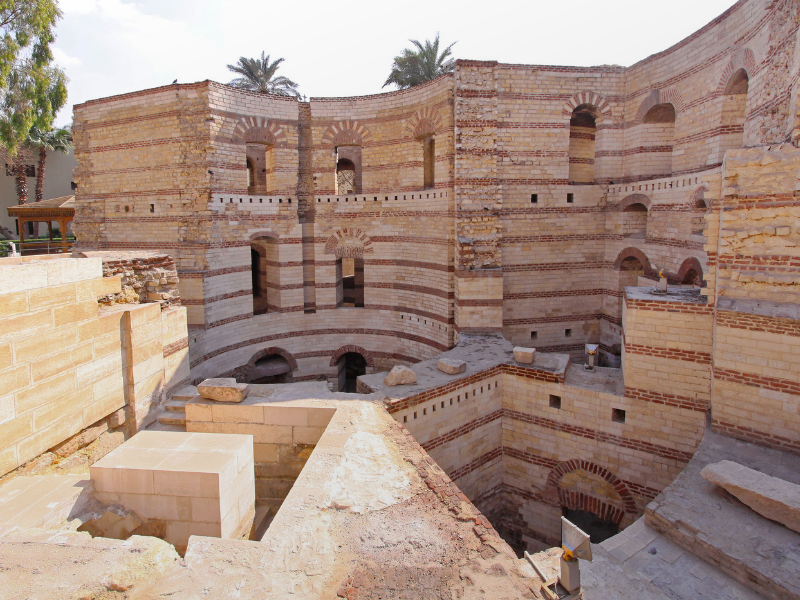
Coptic Cairo, also known as Old Cairo, is an ancient part of the city situated in the south-eastern area beside the Babylon Fortress. This unique neighborhood boasts some of Egypt’s oldest churches, synagogues and Roman fortresses which serve as a testament to its rich history. It is a must-visit destination for any traveler interested in religious or cultural history.
Historical and Cultural Significance
The Hanging Church: One of Coptic Cairo’s most famous attractions is Saint Virgin Mary’s Coptic Orthodox Church (commonly called the Hanging Church). Built on top of one of the fortress gatehouses dating back to 3rd century AD, this church is believed to have been called “hanging” because it was constructed over passageways leading into Roman water reservoirs.
Ben Ezra Synagogue: Also located within Coptic Cairo is Ben Ezra Synagogue – one among oldest synagogues not just in Egypt but all over Africa too. Many historic Jewish manuscript fragments were discovered here during 19th-century renovations; these are collectively known as ‘Cairo Geniza’.
Architectural and Artistic Highlights
Ravenna Mosaic: Amongst several other treasures housed inside these age-old holy buildings lies a mosaic made up mostly Byzantine tiles which depict saints and angels against gold backgrounds – truly breathtaking stuff when seen close enough.
Basilica Architecture: There are many basilicas scattered throughout old Coptic Cairo that showcase different aspects from various periods including styles influenced by both Greco-Roman civilizations alongside those introduced after Islamic conquests took place within Egypt itself such as at St. Sergius & Bacchus Church (Abu Serga).
Nearby Attractions
- Roman Fortifications: The remains left behind by Romans who once occupied this area can still be seen today beneath what we now call ‘Old Cairo’; these include parts belonging specifically only unto themselves like towers or gates but sometimes even entire walls too – such as those forming part of Babylon Fortress itself.
- Saints Sergius and Bacchus Church (Abu Serga): Legend has it that Joseph, Mary and Jesus rested here whilst on their flight from Herod’s persecution of infants in Bethlehem. This is why many people refer to it simply as “the Holy Family Church” although its correct name is actually St. Sergius & Bacchus; either way though, you won’t find too many churches around world claiming association with events described so vividly within New Testament.
- Islamic Cairo: Islamic Cairo offers visitors an opportunity not only see bustling markets offering all kinds Arabic wares imaginable ranging anywhere between spices through silver jewelry right down souvenirs galore but also take step back time visit some truly magnificent mosques built during various periods throughout Islamic history… truly spectacular indeed.
Hanging Church
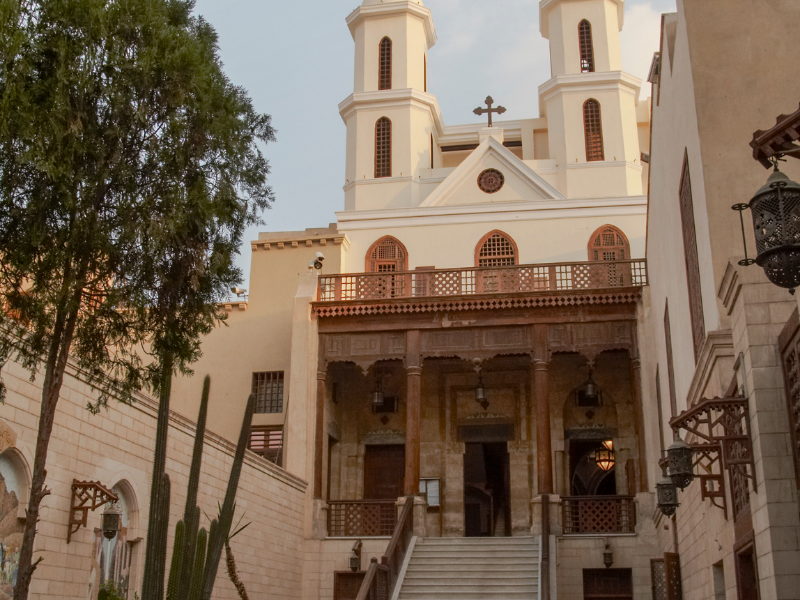
Known as Saint Virgin Mary’s Coptic Orthodox Church or the Hanging Church, this structure is one of the most well-known Coptic Christian churches situated in Cairo. The Hanging Church is an architectural masterpiece that was built on top of two towers of a former Roman fortress; it appears to float over the ruins hence its name. It was established in the 3rd century and underwent several renovations over time making it not only a place for worship but also a historical representation of Egypt’s Christian background.
Architectural and Historical Importance
Distinctive Structure: The church has a nave which hangs above a passage in the old fortress. Another thing that makes it unique are its 13 beautiful arches that symbolize Christ together with his twelve apostles.
Religious Art: Intricate icons, carvings and religious artifacts that date back many centuries can be found within the walls of this church. Its iconostasis made from ebony wood inlaid with ivory is a work of art showcasing scenes from different parts of New Testament.
Cultural and Artistic Highlights
Icons and Artwork: There is an extensive collection of Coptic art housed by this church including icons which are believed to be some among Christianity’s oldest ever made. These artistic creations were not only created for religious purposes but they also play a significant role in tracing the development course followed by Coptic arts overtime.
Architectural Layout: It’s worth noting that inside this building there lies wooden roof whose design resembles Noah’s Ark; this is meant to represent ship shape so as to symbolize Church while at same time signifying hope amid chaos during life’s journey since it’s believed that through storms may believers always be guided safely.
Nearby Attractions
- Coptic Cairo: This establishment forms part of what is known as Coptic Cairo where visitors will find other important sites such as The Coptic Museum, The Church Of St. Sergius And Bacchus, The Ben Ezra Synagogue among others.
- Cairo Citadel: Located not very far from here, this historic fort offers breathtaking views overlooking the entire city plus provides an opportunity for people to learn more about Islamic heritage found in Cairo.
- Al-Azhar Park: A large public park which is situated close by; it serves as perfect location for taking leisurely walks after visiting Hanging Church since there are beautiful gardens within as well as additional spots where one can have scenic view of historical parts city.
Ben Ezra Synagogue
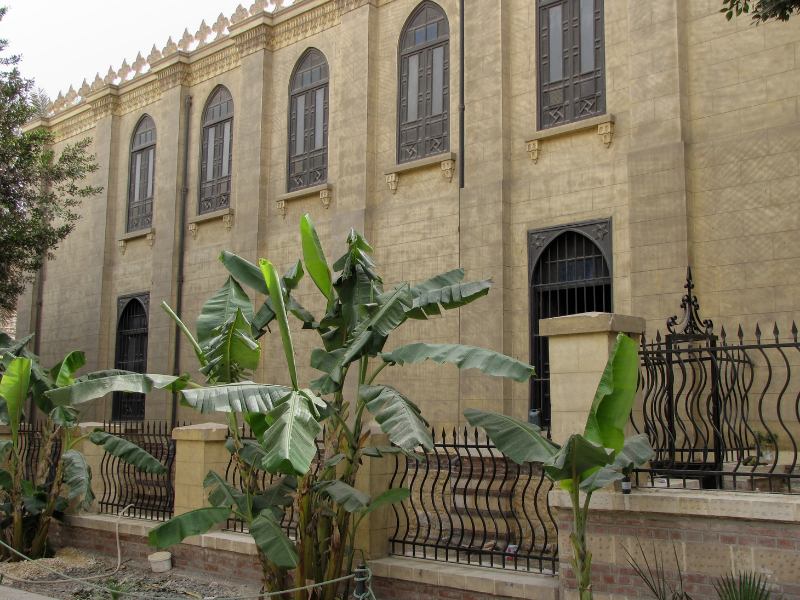
The Ben Ezra Synagogue is located in the narrow streets of Coptic Cairo. It is a symbol of Egypt’s rich cultural and religious past. Many people say it is the oldest Jewish temple in Cairo. This synagogue is well known not only for its beauty but also because many archeological finds have been made there such as the discovery of the Cairo Geniza, which contained a large number of Jewish manuscripts that provided invaluable insights into medieval life under Islam.
Historical and Cultural Importance
Long History: According to local legend this building stands where Moses was found among bulrushes by Pharaoh’s daughter. So this adds biblical significance to an already impressive heritage.
The Cairo Geniza: In 19th century storerooms within this building were discovered over two hundred thousand fragments from books written on paper or parchment between 5th-19th centuries AD; these writings are key sources about social, economic and cultural life among Jews living in Arab countries during medieval times.
Architectural Features
Design and Restoration: The structure follows a basilica plan common to many old synagogues; it was restored in1890s thanks to funding from French government.There are different styles represented in the design including Islamic influences shown by arch-shaped windows decorated with geometric patterns.
Interior Artistry: Decorations inside reflect restrained beauty associated with places used for worship as well spirituality expressed through Hebrew inscriptions carved into walls together with intricate woodwork that testifies skillfulness displayed by those who built them.
Nearby Attractions
- Hanging Church: Another must-see religious site just footsteps away from here. It forms part of Coptic Cairo’s holiness panorama.
- Coptic Museum: Not far off either – you’ll find lots more artifacts related to Egyptian Christianity at this museum which also provides wider understanding around religious beliefs practiced within area over time.
- Church Of St. Sergius And Bacchus: There’s even more! This church sits atop a cave where tradition holds that Mary, Joseph and Jesus rested while fleeing from Herod.
Islamic Cairo

Islamic Cairo, or rather an integral part of central Cairo, is complete with historical mosques, madrasas (schools), hammams (baths), and fortifications that date back to the Islamic era. Called “Historic Cairo,” it was declared a UNESCO World Heritage Site for being a living medieval architectural legacy whose street patterns have not changed since the Middle Ages and where the human activities of the ancestors are still loudly echoed by its vibrant life up till now. Over centuries, Islamic Cairo has been a cultural center that gives rare insights into everyday life and religious practices of people who lived there in different times.
Historical and Cultural Value
Architectural Wonders: This place has hundreds of registered historical buildings; among them are some of the most beautiful examples of Islamic architecture in the world like Mosque-Madrassa of Sultan Hassan, Al-Azhar Mosque or Mosque-Madrassa of Sultan Hassan.
Cultural Heritage: Islamic Cairo isn’t just about monuments; it’s an active part of town with markets still going on today where generations have shopped alongside each other for years – these include shops selling clothes from all over Egypt as well as tea houses which serve as meeting points for locals who want to catch up on gossip while enjoying their cups together.
Lively Streets & Markets
Khan El Khalili: Dating back to 1382 AD, this is perhaps one of the most famous markets not only in Egypt but also worldwide. Here you can find anything ranging from spices through perfumes up until jewelry or souvenirs thus giving your senses a real treat with all its colorful sights sounds smells etcetera…
Local Cuisine: When visiting don’t forget trying out typical Egyptian street food such as koshary – pasta mixed with rice lentils chickpeas topped caramelized onions tomato sauce – available at many small inexpensive restaurants around hereabouts.
Artistic & Architectural Gems
Mosque-Madrassa Of Sultan Hassan: This huge religious & educational complex was built in mid 14th century; it is famous for its gigantic size, innovative architectural design among other things.
Al-Rifa’i Mosque: Located across from Mosque-Madrassa Of Sultan Hassan; this mosque contains the tombs of members of the Egyptian Royal family and also the Shah of Iran thus showing historical links between these two regions.
Nearby Attractions
- The Citadel: Just a short drive away from Islamic Cairo there lies this historic fortress which offers magnificent panoramic views over Cairo city plus hosts several museums as well as ancient mosques within its walls.
- Al-Azhar Park: Situated closeby, Al Azhar Park is one among Cairo’s largest green lungs where you can take a break from chaotic streets relax while looking at beautiful skyline especially during sunset.
Sultan Hassan Mosque

The King Hassan Mosque of Sultan in Cairo is more than a place of worship; it’s a magnificent example of Mamluk architecture that has withstood time. Constructed between 1356 and 1363 by Sultan Hassan, this mosque ranks among the largest worldwide and represents one of Islam’s most significant architectural achievements. Its grandeur and complexity are a reflection of Mamluk ruler ambition and piety which makes it an essential visit for anyone interested in Egypt’s cultural heritage or history.
Architectural Significance
Design: It is admired as a wonder of medieval architecture due to its enormous rectangular plan enclosing an open courtyard larger than any other such structure. Four massive iwans form the perimeter wall with each representing one Sunni school thought while the minaret rises high above them all.
Symbolic Importance
Cultural Uses: Over time, different roles were played by the Sultan Hassan Mosque besides being just another religious site; it also served as a madrasa and mausoleum for its founder. The walls have witnessed centuries upon centuries worth of Cairo’s past events thus serving as backdrop to many historical happenings.
Artistic Significance
Interior Splendor: Inside this mosque you will find tall vaulted ceilings adorned with intricate arabesque work, Quranic inscriptions lining every inch possible along with delicate mosaics covering marble-clad prayer niche (mihrab). All these represent various fine points in Islamic calligraphy as well tile craftsmanship typical for such buildings.
Craftsman Skills Displayed
Engineering Marvels: The lamp used to hang from top dome through a chain so that it illuminates wide space below is indicative enough how much skill was employed during construction works done by Mamluks at this mosque alone not forgetting their other accomplishments elsewhere too which they built over years from 1250 AD onwards till late 15th century AD when Ottomans took over power thereabouts.
Nearby Attractions
- Al-Rifa’I Mosque: Standing right next-door to Sultan Hassan Mosque, Al – Rifa’i mosque is a study in contrast with its more modern style and serves as the burial place for kings of Egypt such as King Farouk among others.
- Cairo Citadel: A brief stroll away from Sultan Hassan Mosque stands this historical fortress that provides panoramic views over Cairo city while housing several museums besides other notable mosques within its precincts like Al-Nasir Muhammad Ibn Qalawun Madrasa etcetera.
- Museum of Islamic Art: This short drive from the mosque will take you to one of world’s richest collections on Islam housed in textiles, ceramics, woodwork and glass among others.
Al-Rifa’I Mosque
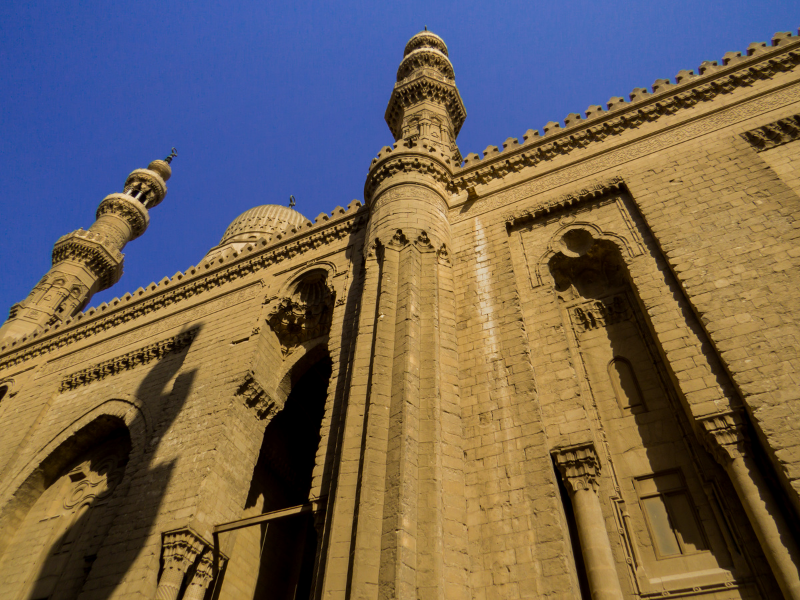
Next to the Sultan Hassan Mosque, is situated Al-Rifa’i Mosque which is an architectural opposite in Cairo’s historic district. It was built between 1869 and 1912 as not only a place of worship but also a tomb for Egypt’s royal family and other important political figures. The new architectural style employed during construction combines different elements of Ottoman and Mamluk designs thus making it look unlike any other mosques around this area – an old neighborhood – thereby becoming one among many must-sees while exploring Cairo’s rich historical and cultural tapestry.
Architectural and Historical Significance
Royal Resting Place: One notable thing about Al-Rifa’i mosque is that it serves as the final resting place for some members of Egyptian royalty such as King Farouk who was the country’s last reigning monarch. Furthermore; even Iran can take pride too since there lies Mohammad Reza Pahlavi’s grave; he happened to be their last Shah ever before Islamic Revolution took over power in Tehran.
Architectural Design: This mosque boasts having tall minaret with huge ornamental surfaces inclusive of an impressive dome. Its interiors feature beautiful Islamic calligraphy on ceilings while walls are adorned with lovely marble panels.
Cultural and Artistic Highlights
Interior Splendor: The inside part of Al-Rifa’i Mosque takes your breath away! That spacious hall, lively carpets together with those chandeliers lighting up all those rich decorations… they make you never want to leave. In fact, through medieval times down till now being blended with modern Islamic art forms would create visual dialogues between what has always been there before now showing us where we currently find ourselves within such spaces like these ones – so full of history yet still alive.
Craftsmanship & Art: Within this period were undoubtedly great craftsmen doing such things because during its construction metalwork alone must have gotten so much attention if we consider how good they used woodwork while stained glass could only be described as among the best works ever produced by those artisans around late 19th early 20th century.
Nearby Attractions
- Sultan Hassan Mosque: Al-Rifa’i is just few steps from here which will bring out not only appreciable difference between two but also enhance understanding about both structures better.
- Cairo Citadel: A short drive away stands this historical fortress that offers panoramic views over Cairo where many museums including some showcasing historical mosques are housed within its precincts.
- Museum of Islamic Art: A museum located a few minutes’ drive from Al-Rifa’i mosque; it boasts one of world’s most significant collections of Islamic artifacts hence adding more value to our appreciation of artistic heritage seen at Al-Rifa’i.
Museum of Islamic Art
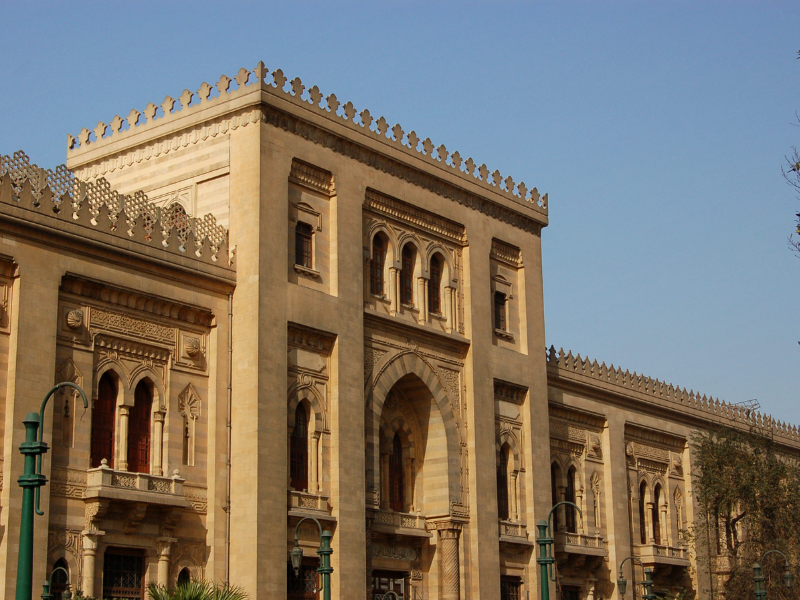
One of the most important repositories of Islamic relics worldwide, the Museum of Islamic Art is located in the historical center of Cairo near busy Bab el-Khalq area. Built in 1903, it has an extensive collection that covers more than one thousand years of Islamic history across regions from Spain to India. There is no other place on earth where you can find so many different kinds of arts such as ceramics, textiles or metalwork that provide an unprecedented appreciation for what these civilizations achieved culturally and artistically.
Importance in terms of architecture and history
Design: The museum itself it’s a jewel on its own with a neoclassical style which was redecorated recently so as to exhibit all its ancient works over two levels. Calligraphy and other decorative elements from Islam can be seen at the entrance as well as throughout this building.
Selection process and exhibition planning: This facility owns about 100 thousand objects among them are rare manuscripts like Quran copies written during different periods; astrolabes – astronomical measuring instruments; ceramics (from different countries); tapestries and armor etc., displayed according to thematic areas or chronological order aimed at giving visitors comprehensive understanding about richness diversity expressed through various forms within Islamic cultural heritage.
Cultural and artistic highlights
Manuscripts and books: Among many valuable pieces held by Egyptian authorities some were chosen here because they show best examples ever made by Muslims across centuries when calligraphic art reached its apogee worldwide. Those include old copies decorated with gold leaf or silver ink while others were bound using finest materials known at that time like mother-of-pearl plates covered sewn together with silk threads so fine you can hardly see them without magnifying glass.
Decorative arts: Each masterpiece reveals certain details indicative particular age where it was produced besides reflecting specific aesthetic principles followed artists involved into creating those objects. For instance metalwork made during Mamluk period displays high degree technical skills required for such complex tasks as casting intricate designs into bronze alloys with different colors achieved through patination process; Iznik tiles represent classical Ottoman style originated in Turkey although widely adopted throughout Islamic world; Persian miniatures tell us about how these paintings became popular across Safavid empire etc.
Nearby Attractions
- Cairo Citadel: This ancient fortress is just few kilometers away from our destination site offering amazing views over whole city especially during night hours when lights turn on illuminating streets below where countless cars move back forth while many people are still out there shopping or going somewhere else so mosques museums within this complex can be visited too.
- Khan El Khalili Bazaar: Known worldwide as one of most vibrant markets not only in Egypt but also worldwide, Khan El Khalili Bazaar will never stop amazing anyone regardless their nationality social status age because here you’ll always find something interesting for yourself your loved ones while wandering around its narrow crowded alleys full traditional crafts souvenirs jewelry spices perfumes clothing items leather goods etc., all sold at affordable prices by friendly shopkeepers eager to share their experiences with everyone who walks past them.
Cairo Tower
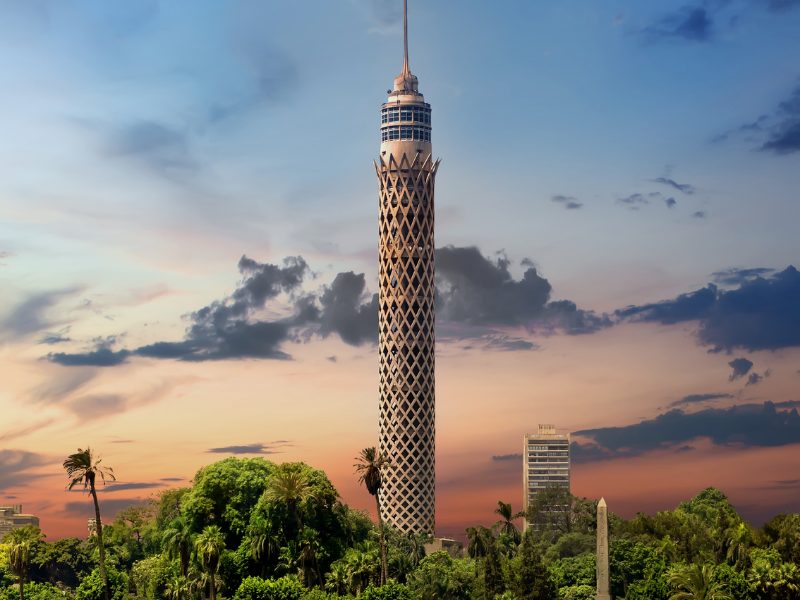
Cairo Tower is among the most notable modern engineering achievements in the city of Cairo and also a symbol of Egypt’s architectural prowess. It stands on Gezira Island in the Nile River, towering 187 meters above ground level. This tower is not only the highest building in Egypt but also an observation deck that presents 360-degree views over Cairo— from downtown streets to Giza pyramids Built between 1956 and 1961 with reference to Pharaonic history as well as other ancient symbols prevalent throughout Egyptian culture; its design resembles that of a lotus leaf.
Architectural and Historical Importance
Planning and Construction: The idea for this structure was conceived by Naoum Chebib, an Egyptian architect who took inspiration from the lotus flower—an essential icon in ancient Egyptian society when coming up with its blueprint. The outer layer consists mainly of reinforced concrete while granite sourced from Aswan has been used extensively as part of its lattice work making it both technically challenging achievement and cultural affirmation towards egyptian heritage.
Historical Background: In the midsts cold war era diplomacy effort funded by United States during times when significant political changes were taking place within Cairo, such a back story behind any monumental building adds much more intrigue value than what meets eye already.
Nearby Attractions
- Zamalek District: Zamalek district encompasses rich neighbourhood living around cairo tower found within gezira island boasting quiet leafy streets lined with international restaurants alongside numerous art galleries thereby creating serene environment contrasting sharply against chaotic city centre life.
- Opera House: Situated at opera square cairo tower located on gezira island, cairo opera house serves major role as venue where different kinds cultural performances are held including ballets operas concerts classical music etc which makes it possible for people who are near by not only experience beauty presented here but also get enriched culturally too being so close to this magnificent piece architecture there can be no better way one should spend their evening time during visitation to cairo tower itself.
- Egyptian Museum: Located just next door to the Egyptian Museum a short distance away from Cairo Tower, this world-renowned museum is home to one of the largest collection of ancient egyptian artifacts in existence today, including Tutankhamun’s treasures.
Abdeen Palace
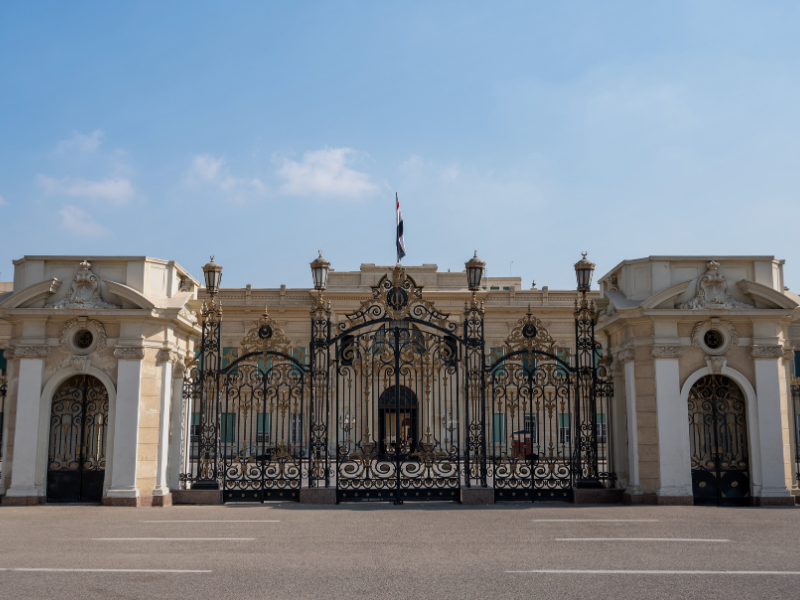
Abdeen Palace is located in the very center of bustling Cairo. The palace is a historic architectural wonder and a testimony to the dynastic and political history of Egypt too. In 1863, Khedive Ismail Pasha built this structure, intending it to be grander than any royal residence in Europe. Abdeen Palace combines Islamic artistry with 19th-century elegance. This museum exhibits royal artifacts today while still serving as a presidential residence for state ceremonies thus reflecting its ongoing role within Egyptian political life.
Architectural and Historical Importance
Design and Construction: With its rich design and lavish interiors that include huge halls embellished by intricate decorations, vast gardens around it and an imposing facade; Abdeen Palace is considered one of the most luxurious palaces on earth. It has brought together various architectural styles from Turkey through France all the way down into Italy thereby making this place unique culturally.
Historical Significance: Having been host to many events which shaped modern day Egypt like abdications among others; Abdeen palace can rightly be said to have played some roles towards shaping contemporary Egypt.
Cultural and Artistic Highlights
Museums and Exhibitions: There are different museums housed within Abdeen Palace complex such as Silver Museum, Arms Museum, Royal Family Museum, Presidential Gifts Museum etc., each offering visitors an opportunity to see how extravagant lifestyles were lived by Egyptian monarchs as well gifts exchanged between world leaders.
Art Collections: For decades now Kings/Queens have collected numerous pieces of fine arts including paintings, statues or even rare decorative objects they are all kept here at this place.
Nearby Attractions
- Tahrir Square: This square lies just adjacent to the palace where many significant political events in modern Egypt took place.
- Egyptian Museum: Also situated close by Tahrir square; it houses huge numbers ancient egyptian artifacts inclusive treasure trove belonging Tutankhamun himself.
- Downtown Cairo: Around Abdeen palace there exists downtown area filled with 19th century buildings which are well preserved till date; these vibrant streets offer shopping opportunities as well restaurants where you can enjoy delicious meals while observing everyday life activities carried out by Cairo inhabitants.
Al-Azhar Park

Situated in the historical setting of Cairo, Al-Azhar Park is a quiet place to rest from the hustle and bustle of city life. Since its opening in 2005, this urban oasis has been covering an area of 30 hectares demonstrating not only Cairo’s commitment to sustainable development but also serving as a cultural heritage site where visitors can enjoy stunning panoramic views over the city skyline including such landmarks as the Citadel and Mosque of Muhammad Ali. The park was established by Aga Khan Trust for Culture who turned it from a heap of rubble and debris into one of Cairo’s largest green spaces.
Cultural and Environmental Significance
Historic Restoration: Located near Darb Al-Ahmar district which is known for its rich history dating back centuries ago; therefore, construction works carried out at Al Azhar park helped revitalize this neighbourhood too. In fact, creating such parks forms part wider efforts aimed at conserving Islamic heritage sites within Cairo.
Eco-Friendly Design: This park offers sustainable living environment within an urban setup through features like well-maintained gardens with diverse plant species, water bodies that support different ecosystems while enhancing biodiversity hence acting as natural coolants for nearby regions.
Nearby Attractions
- Citadel of Cairo: A walkable distance from Azhar Park lies this fortified structure that provides insights into various aspects related to military architecture during different periods under Islamic rule in Egypt (1183-1848 AD).
- Mosque of Ibn Tulun: Being one among oldest mosques found hereabouts; it boasts having unique spiral minaret whose topmost point overlooks most parts surrounding areas giving visitors rare opportunity see whole town from above level ground.
- Khan El Khalili: Situated just short drive away after leaving behind Al Azahar Gardens compound; it remains vibrant market famous for selling handmade crafts alongside other traditional items such as jewelries or spices among others.
Gayer-Anderson Museum

At the very center of Old Cairo, next to the Mosque of Ibn Tulun, there’s a place called the Gayer-Anderson Museum. It shows what life was like for an art collector living in Egypt during the early 20th century. This museum is named after Major R.G. Gayer-Anderson — he lived there and collected lots of different kinds of art as well as furniture and things that seemed interesting at the time.
The museum is located in two houses from the 1500s and 1600s that are connected on the inside, which are called Beit al-Kiritliya. Nobody knows about this place but it should be more popular because not only does it have a wide range of items on display, but also it preserves Ottoman period domestic architecture too; so if you like history or art then go here immediately.
Architectural and Historical Importance
Buildings with History: A third-floor bridge connects two old houses used as a joint museum space – Gayer Anderson House and Amna bint Salim House – both from different time periods representing residential design during Ottoman rule over Egypt.
Efforts made towards conservation: These buildings were carefully restored back into how they would originally have looked like so visitors can see them in their authentic ancient setting thus giving one an opportunity to travel back through ages within Old Cairo.
Cultural and Artistic Highlights
Collection diversity: A variety of objects are displayed at this establishment all collected by Gayer Anderson ranging from Egyptian pieces such as Pharaonic antiques to Islamic manuscripts; Persian carpets among many others while also including some European works too.
Interior decor: Every section or room around this facility has its theme reflected through specific types gathered together within elaborate interiors featuring carved wood paneling alongside mother-of-pearl inlay plus hanging textiles etcetera.
Nearby Attractions
- Ibn Tulun Mosque: Located right beside this place is one of Cairo’s oldest and largest mosques which boasts an exceptional minaret design as well as a huge prayer hall.
- Al-Azhar Park: Just a short drive away lies Al Azahr park where one can find green landscapes coupled with breathtaking panoramic views spanning across different parts of town covering the historical district up to downtown Cairo itself.
- Islamic Cairo: There are many other historical sites dotted around here like Madrasas, Mosques, and Bazaars hence providing you with an opportunity to appreciate more deeply Islamic roots within Egypt’s capital city.
Nilometer
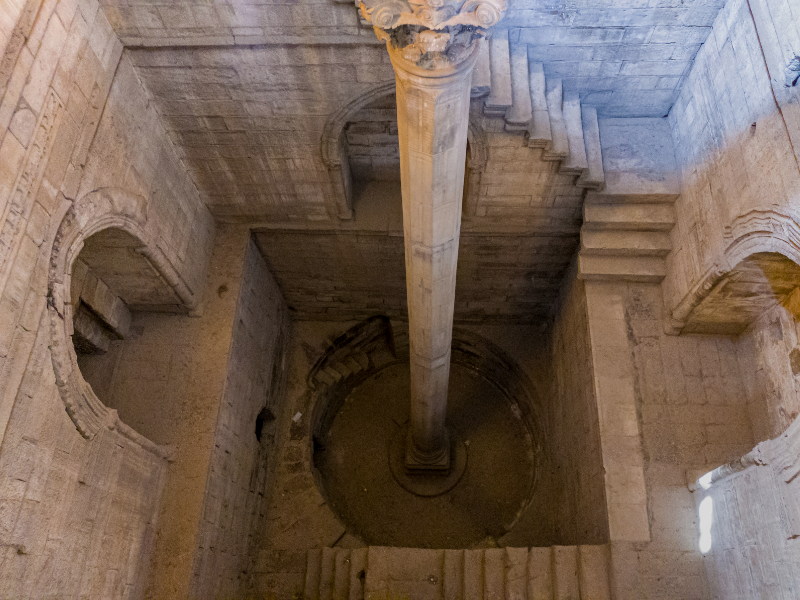
Situated in the south of Roda Island, Cairo, the Nilometer is a marvelous example of the creativity and skill that characterized ancient Egypt’s engineering and architectural works. Built around the 9th century, this building served as a tool for measuring water levels in the Nile River and predicting its annual flood. Agricultural planning heavily relied on this information which also had an effect on tax rates through crop yields among other things. Today, besides being an enchanting attraction where science, history, and architecture meet; it provides insight into some interesting aspects about hydraulic systems in Egypt.
Relevance to Architecture and History
How it was made: The Nilometer located on Roda Island has a circular column designed beautifully going down towards the Nile. Observers from long ago used to gauge floods by marking heights along this column. Through pointed arches and a conical dome shape; utility blended with beauty can be seen in every part of its strategic design.
Social Context: In terms of economy or social stability within Egypt’s history there is perhaps no other structure more important than what we call “The Nileometer”. These readings helped determine how much land would be irrigated by flood waters reaching delta areas around river nile having direct implications on regional economics through farming outputs etcetera.
Nearby Attractions
- Manial Palace Museum: This palace museum situated just few minutes’ drive away from nilometer offers visitors chance see some beautiful gardens while providing insights into Egypt’s royal pasts with its highly decorated interiors.
- Al-Azhar Park: With views overlooking cairo city skyline not too far off either direction after spending your day exploring all those historical sites why don’t you just sit back relax at al azhar park which offers panoramic view over whole city itself!
- Coptic Cairo: A short distance away from where you are now standing lies coptic cairo area filled with old churches museums among others giving us opportunity delve deep into religious fabric that makes up this great metropolis.
Mosque of Ibn Tulun
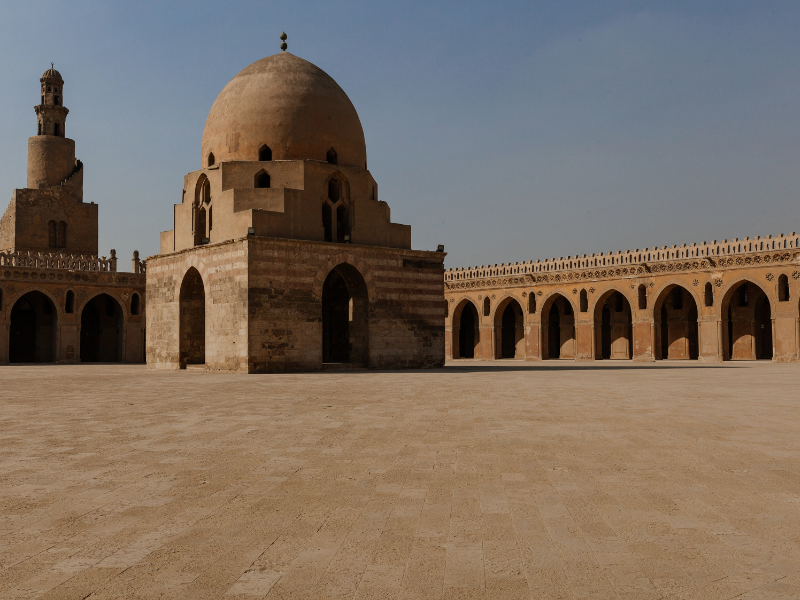
The Mosque of Ibn Tulun is situated in the core of Islamic Cairo and stands as one of Egypt’s oldest and largest intact mosques. Constructed between 876 and 879 AD by Ahmad Ibn Tulun, founder of the Tulunid dynasty, this mosque represents a remarkable example for architectural invention and artistic excellence at that time. The Mosque of Ibn Tulun has a vast courtyard, tall minaret, and unique spiral staircase among other features that make it an exceptional model of medieval Islamic architecture.
Architectural & Historical Significance
Design Elements: It owns one of the biggest open courtyards in Cairo’s mosques with pointed arches and ziyadas (enclosure walls), which shows a different Abbasid style imported from Mesopotamia – thus signifying breakaway from traditional Egyptian mosque architecture during this period.
Historic Minaret: The most outstanding feature may be its minaret. This minaret is different from others in Cairo because it has an external spiral staircase winding around the outside just like what we find on those famous ancient Iraqi ones at Samarra; apart from being visually appealing, such design also represents notable architectural advancements made then.
Cultural & Artistic Highlights
Artistic Decorations: Though simple in nature, this mosque has stucco carvings with geometric patterns on floral motif decorated arches throughout – these are subtle touches reflecting typical artistic taste during that era.
Preservation & Restoration: Several repairs have been carried out mainly to keep its originality intact while maintaining structure stability. These initiatives were aimed at ensuring that other historical mosques within Cairo did not lose their authenticity as examples representing true Tulunid architectural style through later additions which altered their appearance significantly.
Nearby Attractions
- Gayer-Anderson Museum: Located next door but one building away; museum occupies two historic houses displaying various works of art together with antiquities thus enhancing cultural immersion surrounding visits paid to Mosques like this one.
- Khan El Khalili: Bazaar situated not far off from here; travelers looking forward to exploring lively market places of Cairo can spend time shopping around for traditional Egyptian crafts among other souvenirs at Khan El-Khalili.
- Al-Azhar Park: Large public park closeby where visitors can have peaceful walks enjoying greenery while taking in breathtaking views over Cairo skyline after having toured the mosque precincts.



